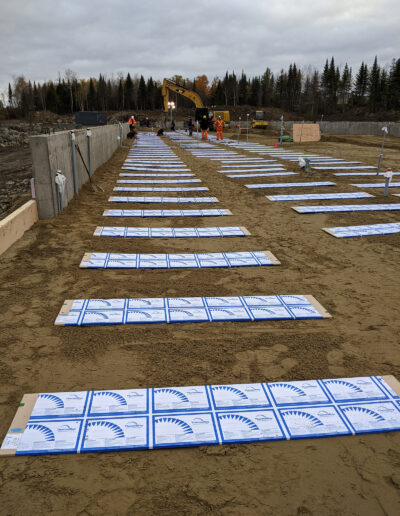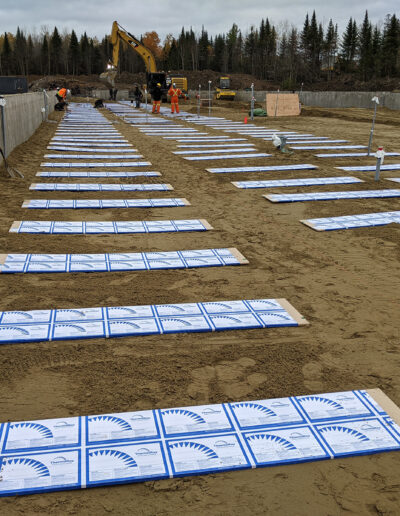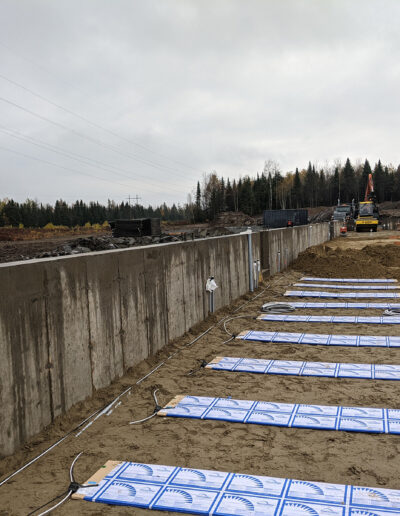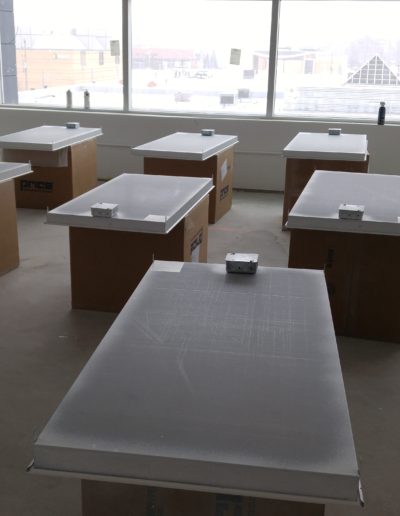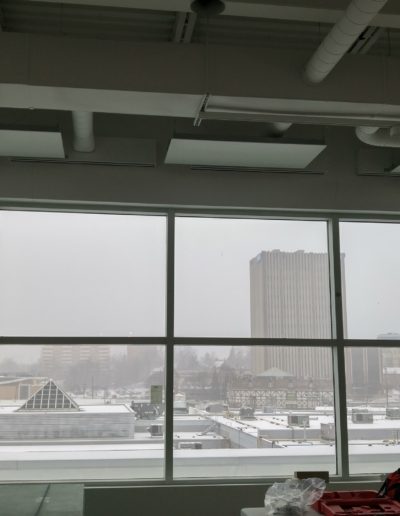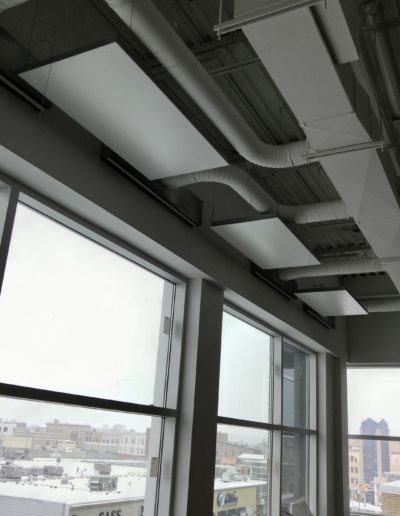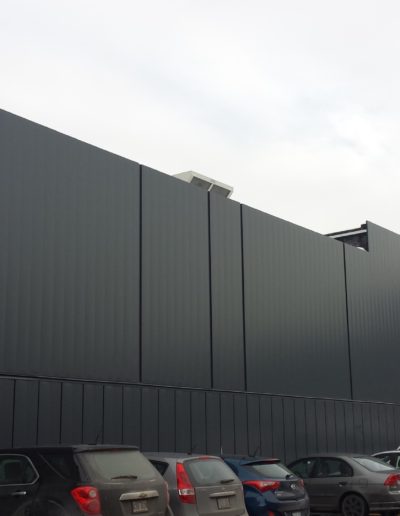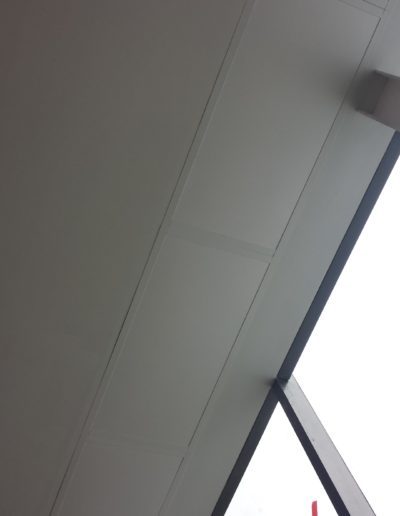Projects
Mr. Jake – Structural Insulated Panels
Owner: Mr. Jake
Architect: Sherri-Lynn Design
General Contractor: The Homeowner
Location: Lake Simcoe, ON
Concept: Approx. 4000sqft high efficiency home on lake Simcoe ON.
Challenge: Mr. Jake wanted to build a high efficiency dream home by Lake Simcoe. The land is too close to the water, therefore the water table is high. Another challenge is that he required much higher standards in his home than the average home, nearing a net-zero home. So we needed to find solutions that work hand-in-hand to guarantee the best result in terms of comfort and energy efficiency. Mr. Jake also was not happy that he is losing approximately 200sqft for the mechanical room.
Solutions: Structural Insulated Panels of 8.25” thickness for the walls were used, providing an effective R-value of R32, along with high efficiency triple-glaze fiberglass windows. What was important is to provide him with a mechanical system that capitalizes on the efficiency of the building envelop, saves him space while running on a low energy budget. Thermaray’s radiant ceiling panels offered a high efficiency, comfortable heating system, and freed up the mechanical room which initially was supposed to house the furnace and other mechanical components. Additionally, Mr. Jake saved on the sizes of the joists needed for his floors and ceiling, as there are no more large heating ducts passing through them, only an 8” duct for the ventilation system.
Acier d’Armature de Beauce – Earth Thermal Storage
Owner: Acier d’Armature de Beauce (AAB)
Architect: CRÉA Architecture
General Contractor: Construction Binet
Location: Beauceville QC.
Concept: 20,000 sqft factory with approximately 2,000sqft of office spaces for a total of 22,000sqft
Challenge: AAB considered Hydronic radiant heating system, however, the fabrication machine they were planning to install, needed to be bolted to the slab, risking damaging the hydronic tubes installed in the slab. Another challenge is to control the operation cost with the consistently rising gas prices.
Solution: Earth Thermal Storage radiant heating panels are installed 7 – 11 inches below the slab eliminating the risk of damage should the heavy machines be bolted to the slab. The thermal mass that will be built under the slab, will allow AAB to capitalize on Hydro-Quebec’s flexible rates by allowing them to draw energy from the grid during the low-peak, cheaper rate hours. In addition, unlike natural gas, Hydro-Quebec’s rates are a lot more consistent.
Other added benefits of going with the Earth Thermal Storage radiant heating system:
- Cheaper system to purchase than the hydronic system
- Cheaper system to install
- Saved AAB on slab insulation cost, as the system does not require and is exempt from insulating the slab
- Cheaper operational costs
- Significantly reduced the size of the mechanical room
- Allowed for better zoning and control
- Maintenance free and no replacement parts
- Zero CO2 emission produced by the Earth Thermal Storage radiant heating system
Stackt Market – Radiant Ceiling Panels
Owner: Stackt Market
Architect: LGA Architectural Group
General Contractor: Astound Group
Location: Downtown Toronto
Concept: Artisanal Market built of shipping containers stacked on top of each other
Challenge: Containers don’t have enough room for ducts. It is also complicated to bring in a natural gas line to them. A compact energy efficient solution was needed as alternative.
Solution: Architectural series radiant ceiling panels provide consistent warmth to the spaces created, in an energy efficient way. The electric panels, installed in the ceiling, are a compact alternative to bulky and unpractical conventional options. The controls are electronic thermostats controlled by the occupants of the containers.
Shopify Customer Service Centre – Waterloo, ON
Project Owner: Shopify
Architect: LineBox Studio
Mechanical Engineers: Smith and Andersen
Location: Waterloo ON.
Concept: Modern customer service office
Challenge: With the modern look and open concept desired for Shopify’s new offices in Waterloo ON, came some heating challenges as the windows were too big, and the forced air system specified was not sufficient to compensate for the heat lost through those windows efficiently.
Solution: Petra’s architectural series radiant heating panels provide gentle, consistent heat that warms up the windows directly and efficiently without the need to warm the air. This process of radiation allows for a more comfortable environment, reduces energy consumption, and eliminates cold draughts, while providing more decentralized controls to maximize comfort.
Queen Victoria Hot Yoga Studio
Owner: Vic Studio
Architect: Maria Gonzalez
General Contractor: Reliance Construction Group
Electrician: La CIE Electrique Britton Ltée
Location: Westmount QC
Concept: A Hot Yoga Studio in the Heart of the Westmount
Challenge: To create a hot yoga studio, where temperatures can reach 40 degrees Celius, without blowing uncomfortable hot air on Yogis, taking into consideration the age of the building and the size of the windows in the studio.
Solution: After a detailed heat loss analysis, Petra’s Architectural Series radiant ceiling (Metal radiant ceiling panels) provided the best heat for the space. The client is able to adjust the temperature to meet the needs of the hot Yoga student without creating an uncomfortable current through blowing hot air. In terms of energy consumption, it is by far the most energy efficient option since it eliminates infiltration and exfiltration and provides a consistent heat from ceiling to floor.
The Nouvelle Scenes Theatre
Engineers: WSP
Electric Contractor: Dandrew Technologies
Location: Byward Market, Ottawa, ON
Concept: A culture center and theatre
Challenge: This modern building has a perimeter with 22 ft high windows, which creates a challenge to warm up the space and to warm up the surfaces of the windows to avoid condensation and cold draughts, in an efficient way.
Solution: The Architectural Series radiant ceiling panels provide an energy efficient solution as the radiant heat warms up the surfaces of the windows, reducing the delta temperature between the ambient air and the windows’ surfaces. The result is a comfortable space, with no cold draughts, no condensation on the windows and a massive saving on the energy consumption and maintenance costs.










